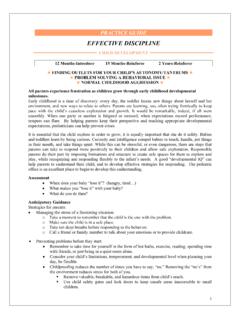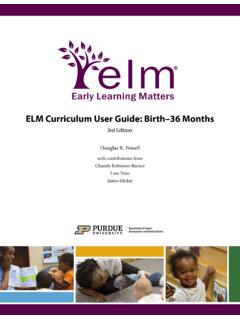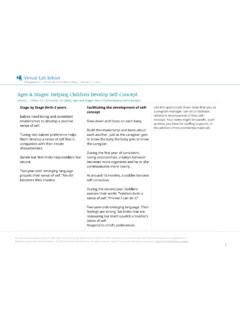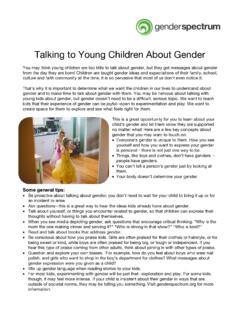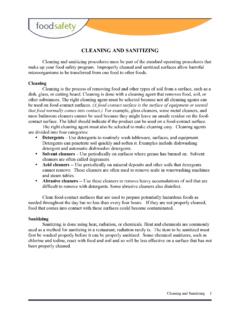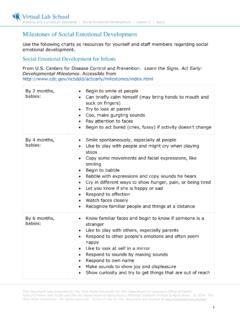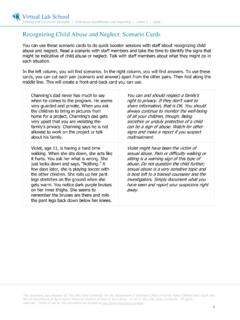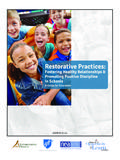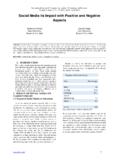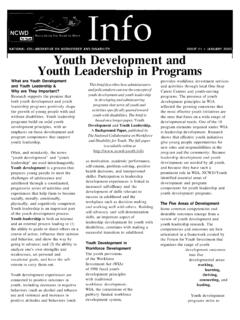Transcription of Child Care Staff Evaluation - Virtual Lab School
1 management | positive Guidance | Lesson 3 | Apply This document was prepared by The Ohio State University for the Department of Defense's Office of Family Policy/Children and youth and the US Department of Agriculture's National Institute of Food & Agriculture. 2014 The Ohio State University. All rights reserved. Terms of use for this document are located at 1 Child Care Staff Evaluation 2010 Child Care Lounge Whether you are Child -care administrator, director or a supervisor of student teachers; it is likely you will being evaluating caregivers. The Evaluation of Staff serves many purposes. In addition to a tool used for promotion and dismissal, Staff evaluations can be valuable sources of feedback and tools used for professional growth. Used properly, checklists and performance appraisals can help promote open communication between the daycare Staff and administration and clarify expectations.
2 Many directors will often give new providers a copy of the Evaluation so that they know what the work expectations are and can measure their own progress. It is helpful to establish a set guideline for when Evaluation will occur. Some programs will schedule Staff evaluations at the end of a probationary period and then annually after that. It is helpful to ask the Staff member to complete the form first, thereby allowing your ratings to show areas of agreement or discrepancy. Sample Evaluation Tool F = Frequently O = Occasionally N = Never General Work Habits F O R Arrives on time x Reliable in attendance x Responsible in job duties x Alert in health and safety matters x Flexible with assignments and schedule x Maintains a positive attitude x Gives ample notice for absence x Remains calm in tense situations x Interaction with Children F O R Friendly, warm and affectionate x Eye to eye interaction x Uses modulated.
3 Appropriate voice x Shows respect for individuals x Is aware of developmental levels x Encourages independence and self-help x Avoids stereotyping and labeling x Reinforces positive behavior x Uses positive discipline techniques x management | positive Guidance | Lesson 3 | Apply This document was prepared by The Ohio State University for the Department of Defense's Office of Family Policy/Children and youth and the US Department of Agriculture's National Institute of Food & Agriculture. 2014 The Ohio State University. All rights reserved. Terms of use for this document are located at 2 Regularly records observations of children x Classroom management F O R Creates an inviting learning environment x Maintains a safe environment x Provides age appropriate activities x Develops goals from observations x Facilitates growth in all areas of development x Serves as an appropriate role model x Anticipates problems and redirects behavior x Is flexible.
4 Responsive to children's needs x Is prepared for the day's activities x Handles transitions well x Working With Parents F O R Available and approachable with parents x Listens and responds well to parents x Is tactful with negative information x Shows respect for those from diverse backgrounds x Maintains confidentiality x Seeks a partnership with parents x Regularly shares information about the Child 's progress x Involves parents in center activities and events x Working With Co-workers F O R Is friendly and respectful x Strives to assume a fair share of work x Shares ideas and materials x Communicates directly, avoids gossip x Approaches criticism with learning attitude x Looks for ways to be helpful x Solves conflict independently x Professionalism and Growth F O R Takes job seriously, seeks skill improvement x Participates in workshops, classes x Sets goals for personal growth x Behaves in an ethical manner x Evaluation Category Examples of behavior management | positive Guidance | Lesson 3 | Apply This document was prepared by The Ohio State University for the Department of Defense's Office of Family Policy/Children and youth and the US Department of Agriculture's National Institute of Food & Agriculture.
5 2014 The Ohio State University. All rights reserved. Terms of use for this document are located at 3 General Work Habits Coach and coworkers note how wonderful it is to work with Marie; they can count on her to be on time and to complete her regular schedule. Marie is sometimes distressed when adaptations need to be made to the schedule to support coworkers training. She sometimes complains about the need to have a floater or substitute on particular days. Working With Children Marie is very responsive to the children, she gets down on their level to have conversations. She observes children s interest and skills and can talk about these, and sometimes creates activities based on her observations. Marie occasionally raises her voice or shows frustration in her work with the children ( , you put paint all over the floor!)
6 Marie also used strong gender messages in the dramatic play area when engaging with the children ( , that pink one is for girls; that blue one is for boys ). Classroom management Marie completes her daily safety checklists and is vigilant about safety throughout the day. She also has worked hard to provide materials at the children s level and create a home-like environment. Marie sometimes lets children negotiate on their own, but also occasionally steps in to say which Child can be next and organizes the play for children. Marie sometimes identifies her own emotions and discusses them out loud ( , I was also frustrated we could not go outside today. I think we should bring out the ball and basket game so we can move our bodies and feel better. ) Sometimes emotional or guidance messages are given in a harsh tone, ( , look what you did!)
7 You made her cry! Would you like that?! ) During transitions Marie displays some frustration. She seems flustered that few children help with clean up and that most children do not go to line up on their own; she provides several reminders. Working With Parents Marie regularly shares stories from the children s day with family members, shares the children s recent work, and speaks with parents about upcoming center events. management | positive Guidance | Lesson 3 | Apply This document was prepared by The Ohio State University for the Department of Defense's Office of Family Policy/Children and youth and the US Department of Agriculture's National Institute of Food & Agriculture. 2014 The Ohio State University. All rights reserved. Terms of use for this document are located at 4 Marie sometimes approaches challenging conversations about children s behavior with family members by asking questions and for their input, but also often emphasizes how the Child s behavior is problematic for the classroom.
8 Working With Co-workers Marie takes an active role in curriculum planning and communicating with families. She sets up, plans, and engages in daily activities with children. She often communicates with coworkers throughout the day to assure all classroom tasks are completed and supervision is distributed throughout the program environment. When a conflict arises between the teachers in the classroom, Marie takes her concerns to the coach before first trying to address the issue with her co-teachers. Professionalism and Growth Marie enthusiastically participates in professional development training offered at Staff meetings. She does not miss Staff meetings. Sometimes Marie has ideas for her professional growth ( , I would like to learn more about open-ended art experiences. ). Additional Comments: Goals for Improvement.
